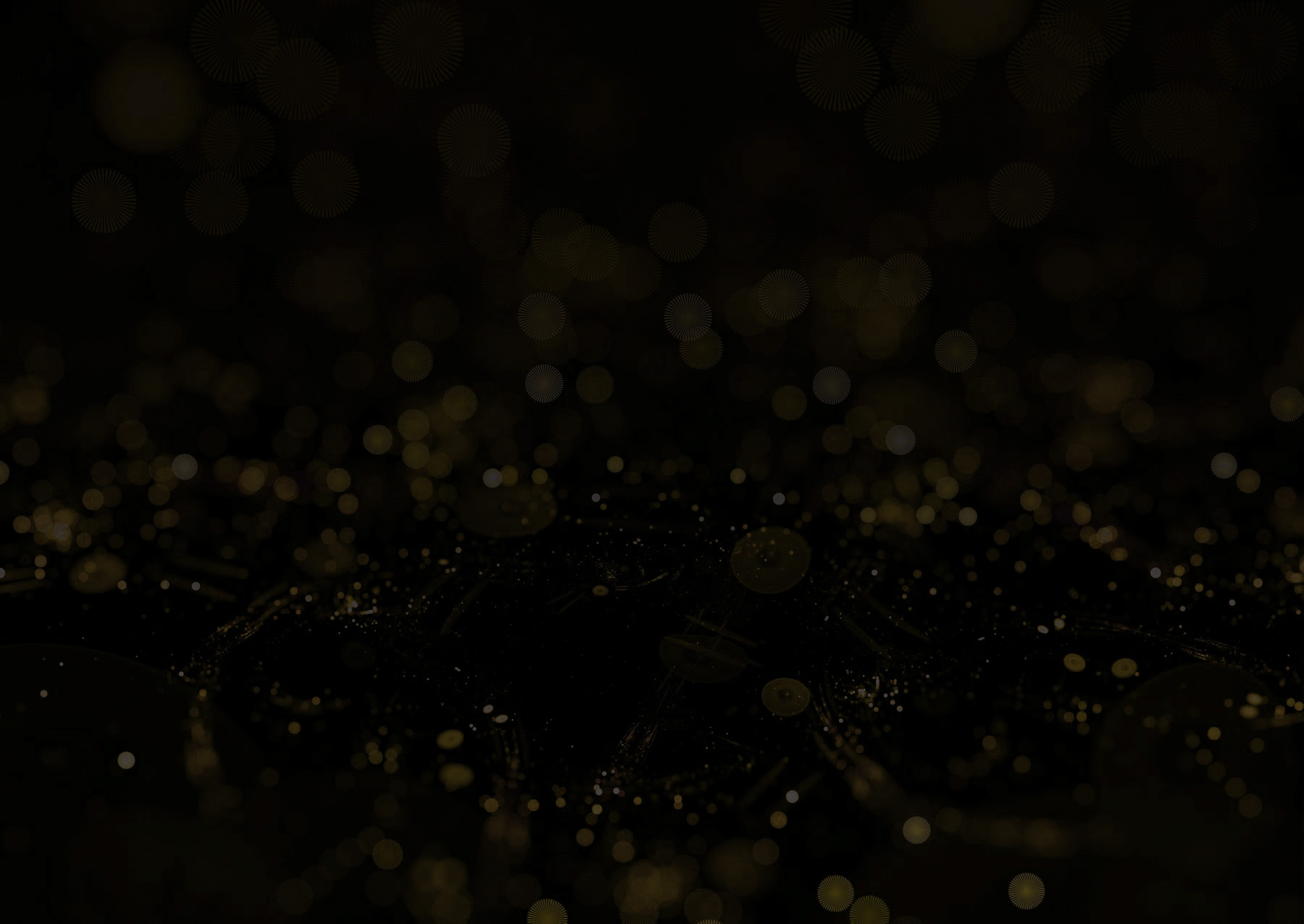
Featured in the Fall 2016 Issue | View Full Issue
Mandi Dillin and team write the book on how the West was won
by Nancy Mills
During her decade as a location manager, Mandi Dillon, LMGI has worked on such demanding productions as Inception, Iron Man 3 and The Revenant. But spending the better part of two years finding locations for HBO’s 10-hour series Westworld was, she says, “the most challenging job I’ve ever had. It was like Transformers meets The Dark Knight meets Django Unchained—all films that she successfully helped bring to the screen.
What did it take to get this job done? “A good sense of humor, a sense of wonder and a sense of adventure,” Dillin says. “If you don’t have the ability to see something that’s not there or can’t imagine how a location can be transformed with a little set dressing, it’s really impossible to do a science fiction/Western/fantasy show within the 30-mile zone in L.A.”
Big demands seem almost like candy to Dillin. “I don’t know many people who think it’s fun to spend months in the dust and the heat surrounded by a bunch of background actors and crew members in the middle of nowhere,” she says enthusiastically. “The adventure and wonder parts of this job keep you on your toes.”
Just how busy was she? “We scouted over 200 locations for season one, and ended up with 30 unique Southern California locations and 12 Utah locations.”
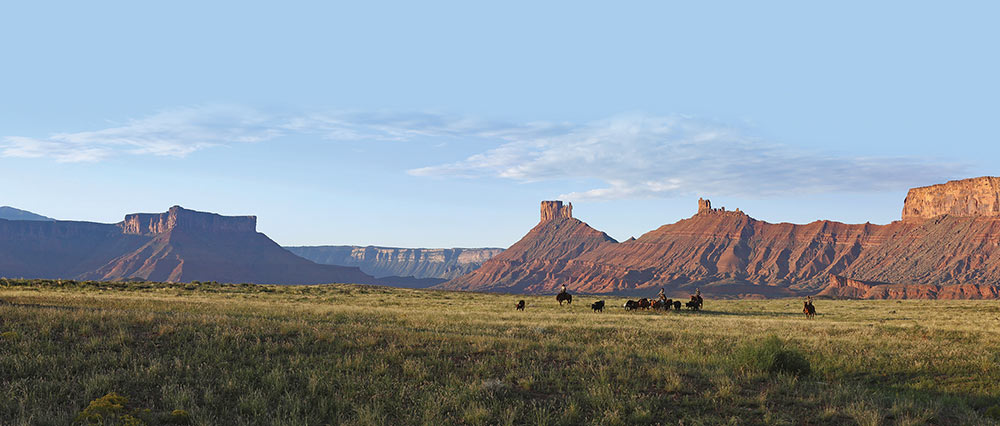
Westworld, whose budget reportedly reached nearly $54 million, stars Anthony Hopkins, Ed Harris, Evan Rachel Wood, Thandie Newton, James Marsden and Jeffrey Wright, among others. It is inspired by the 1973 motion picture of the same name. However, that movie, which was written and directed by Michael Crichton, clocked in at just 88 minutes.
HBO’s new version takes the story in many new directions. According to the network, Westworld examines such issues as “the dawn of artificial consciousness and the evolution of sin. It explores a world in which every human appetite, no matter how noble or depraved, can be indulged.”
The series shot 95 percent in Southern California, although the 10 days spent in and around Moab, Utah, “definitely helped to set the tone and give scope,” Dillin says. “When you’re going to a theme park, you want that sense of awe and wonder. You want to feel you’re along for the ride.”
“HBO had a great success with Game of Thrones,” Westworld creator Jonathan (Jonah) Nolan says. “They understood the advantage of location photography to supplement and enhance—as a garnish rather than the main dish.
 “The challenge with Westworld is that it’s both science fiction and a Western. You’re looking for points of connectivity.” He gives an example. “There’s a scene in the pilot where we needed to shoot architecture on one side of the scene and landscape on the other. We shot the architectural part at the Pacific Design Center (PDC) and the Skirball Center and the landscape at Dead Horse Point State Park in Utah.
“The challenge with Westworld is that it’s both science fiction and a Western. You’re looking for points of connectivity.” He gives an example. “There’s a scene in the pilot where we needed to shoot architecture on one side of the scene and landscape on the other. We shot the architectural part at the Pacific Design Center (PDC) and the Skirball Center and the landscape at Dead Horse Point State Park in Utah.
“The coverage on both sides is real, and we used green screen to cover the transition shots. It was all beautifully done, and it was all due to Mandi ensuring we could make it work.”
Nolan knew Dillin through his older brother, director Chris Nolan, who hired her to do location work on Interstellar and The Dark Knight Rises. The younger Nolan wrote both films.
“Mandi was part of the family, and that allowed for an immediate shorthand,” he says. “It’s impossible to imagine making this series without her. She was completely involved with trying to knit together all these places and making it feel like a real park.
“The complexity of what she pulled off is mind-boggling, and she did it all without incident. We had days when four or five directors were shooting. Imagine trying to shoot three summer blockbusters simultaneously in a half-dozen locations. She’s an MVP for sure.”
Nolan had a strong influence on location choices, especially in Utah. He became familiar with the state during numerous cross-country driving trips. “I thought about that iconic land- scape and wanted to start there,” he says. “When we got to Castle Valley, I said, ‘This looks like Marlboro country,’ and then I found out that some Marlboro commercials were actually shot here. John Ford made his last four pictures here because he got bored with Monument Valley.
“It’s the most absurdly beautiful version of the West that you can imagine. If you stand in Castle Valley with the Colorado River behind you, looking out over the mesas with the snow-capped mountains in the background, you can point the camera in any direction and you get that sense of pure Western spirit and adventure.”
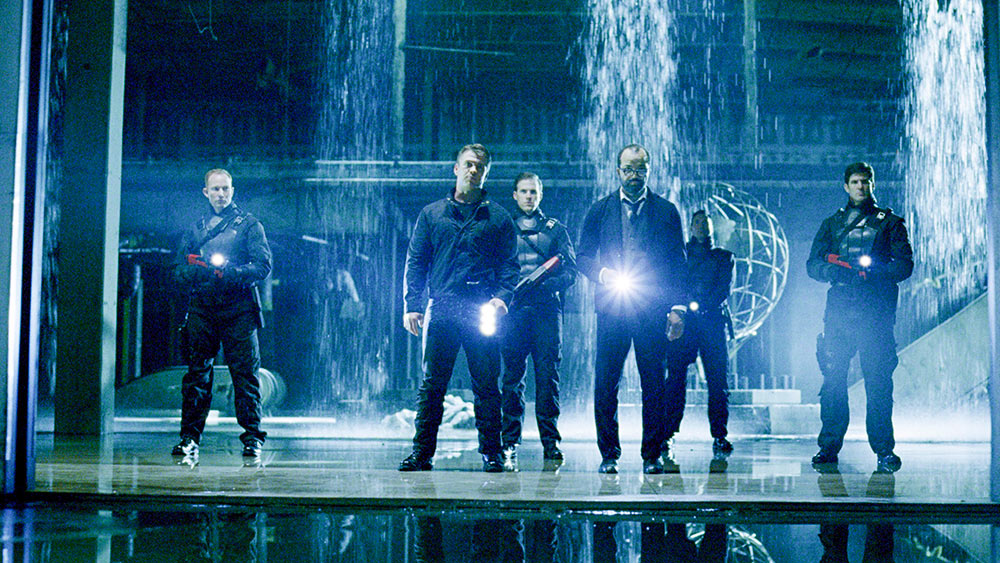
Finding iconic locations was one thing. Making them work in a movie that’s partly science fiction is another. “The extra challenge for us was that Westworld is not a real place,” Nolan says. “It’s a constructed reality. Why would you pay all this money to go to Westworld? What would it make you feel? We wanted to make it feel as real, overwhelming and vital as possible.”
Nolan, who serves as show runner with his wife, Lisa Joy, directed two episodes. He was also involved with writing all 10 episodes. He describes the theme park as “vast. I estimate it being between 300 and 500 square miles and filled with a wide range of terrain—mountains, deserts, rivers and buttes,” he says.
To lock down these locations, Dillin worked with state and national parks and the Bureau of Land Management (BLM). “We’d need permits to shoot on state land and BLM’s approval to land a helicopter but need state approval to refuel,” Nolan says. “It was extraordinarily complex, but with Mandi’s help, we were able to pack in an enormous amount of great material in a relatively short amount of time.”
Westworld started shooting in April 2014 and finished in May 2016. During that time, the production unexpectedly shut down for several months so that the writers could finalize scripts.
During the hiatus, Dillin worked on The Revenant, an experience she found useful when she returned to Westworld.
“The Revenant had a lot of budgetary problems,” she says. “It exposed me to a lot of interesting secrets and methods of how to make a real wilderness film. “Although I had previous experience with working in the snow, The Revenant made Django Unchained look like a ride at Disneyland. We were literally in the middle of nowhere in Alberta and sometimes had dozens of period background actors to manage, not to mention all of their horses and other livestock. The film was all on location in the middle of a snowless but still cold Canadian winter.
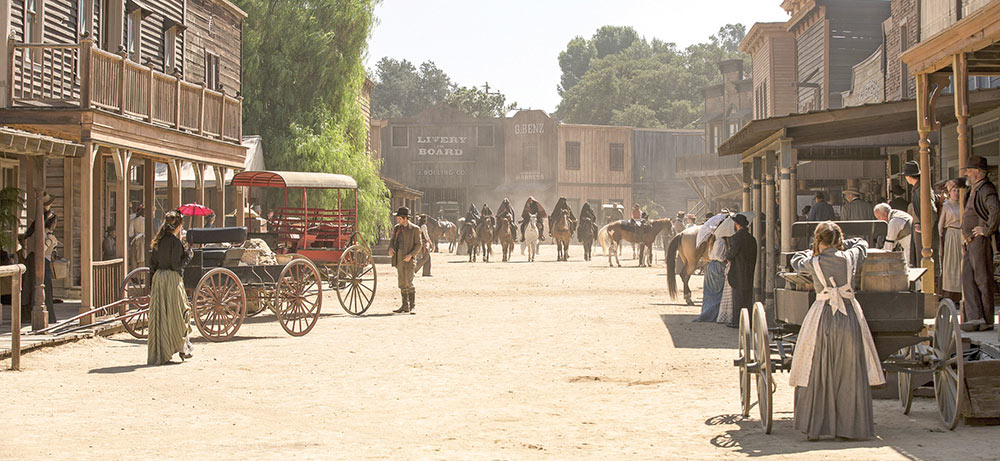
“The Revenant showed me new ways to move people and equipment in the snow and rising river waters. The Canadians used a lot of plastic sleds to cart around camera gear. They were dragged by a small army of production assistants. To avoid slipping on mud and melting ice, we pounded chicken wire and punched steel into the ground to make slip-proof walkways through the forest.
“We had a ‘heat team,’ who was responsible for keeping both the cast and crew warm in the freezing temperatures. That was liter- ally a 24/7 operation. We also had a dedicated group of people who constructed floating plastic bridges across melting rivers and streams, which had to be altered so horses could walk on them without slipping and gear carts could be pushed to location.
“It sounds kind of nerdy to get so excited about all of that, but those little tricks are essential to getting the crew where we need to go in order to make the movie.”
Westworld had more than wilderness on its mind. “We had activity going on in every single corner of Los Angeles County,” Dillin says, “from the South Bay to Simi Valley, from downtown L.A. to Malibu and Ventura County. Sometimes we had multiple units shooting. Sometimes we had daytime filming. Sometimes we had nighttime filming. It really did become a 24-hour operation at times. I tried to keep the hours humane—within a 12-hour-to-14-hour day—although my schedule was a different story, depending on what was going on.”
How did she keep sane? “I just willed myself to not get over- whelmed or discouraged,” she says. “It was a matter of waking up and that was my life. If I think of things as a challenge, they become a duty and they’re no longer fun.”
She also got out her yoga mat every morning. “I would do at least 30 minutes of yoga before leaving the house,” she says. “That changed my life. It gave me the tools to remain calm. Yoga helps relieve stress. You have to focus on what you’re doing for 10 minutes-20 minutes-30 minutes. I had this dream of converting the lunchroom at Melody Ranch into a yoga studio, but there was never any time.”
Dillin’s steady hand inspired her location crew, which numbered as many as 13 at some stages. “Mandi has a very positive attitude and a positive energy, and she carries that day-to-day,” key assistant location manager David Park, LMGI says. “It trickles down through the whole department. She’s a very hard- working, good person, and she has an infectious laugh.
“Westworld was a very difficult shoot in a lot of ways. It had a very large footprint—a feature film-size footprint—that wanted to move at the pace of a TV show. Areas we worked in would be freezing in the morning and extremely hot during the day. But it was still thoroughly enjoyable.”
Adds assistant location manager Tommy Woodard, LMGI, “Mandi takes her job very seriously but knows how to have a fun time. She knows a lot about everything. It’s cool to have someone with that much knowledge around. She’s not a micro manager, and she never yelled. She never chewed you out if you made a mistake.”
Production designer Zack Grobler, who joined the Westworld team after the pilot was shot, quickly bonded with Dillin. “I’m usually doing TV, which has a very short time frame, so I really need someone I can talk to and who can get into my head,” he says. “Mandi is good at that.”
We had two weeks alone at the beginning of production. We didn’t have a script, but Jonah gave me a brief of what he was planning to do, and we watched the pilot. So we’d go out look- ing for potential locations.
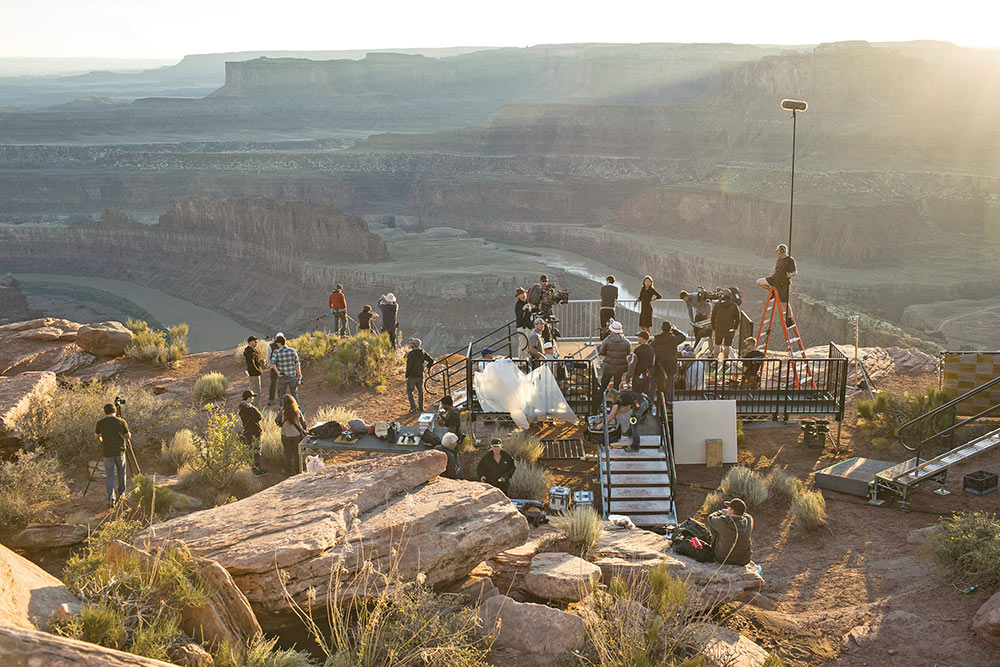
“Mandi’s really good at brainstorming. While we were driving, we’d keep throwing ideas back-and-forth. I’d say, ‘If we had a guy in an abandoned village, where would that be?’ She’d say, ‘I can show you this and this.’ When we started shooting and had the scripts, we had a whole library we could pull from.”
“Zack worked on Lost, which meant that he had a lot of experience creating scope when you had no choice,” Dillin says. “Things would come up at the last moment. Suddenly, Lost needed a cave or a jungle. Zack made sets out of Styrofoam and painted them. He had flexibility and vision, so he made things more manageable.”
 Adds Grobler, “When you’re on one island and they ask you to do different countries and you only have one week, it’s challenging. But Westworld was more complicated and more challenging. “On Lost, you eventually caught the rhythm. You knew you had nowhere else to go and you accepted the limits. With Westworld, we’d be thinking ‘Maybe we can find something bet- ter.’ Then the day before shooting, they’d change the script and want something different.”
Adds Grobler, “When you’re on one island and they ask you to do different countries and you only have one week, it’s challenging. But Westworld was more complicated and more challenging. “On Lost, you eventually caught the rhythm. You knew you had nowhere else to go and you accepted the limits. With Westworld, we’d be thinking ‘Maybe we can find something bet- ter.’ Then the day before shooting, they’d change the script and want something different.”
Perhaps the biggest challenge was shooting at the Pacific De- sign Center in West Hollywood. “It was one of our high-end modern locations,” Park says. “It involved a lot of sets—the lab- oratories, design labs and the modern-day world of the innards of Westworld, where everything is created and controlled.”
“Jonah really liked the PDC,” Grobler says. “He and (pilot) production designer Nathan Crowley based a lot of the look of the show on that design. We only went for one night, and the shops closed at 6 p.m.
“My construction team needed to cover 600 feet of shop fronts with black anodized set flats (or set walls) and said it would take eight hours, but I said we only had two. We ended up hav- ing several teams working in different areas simultaneously, frantically covering up shops as they started closing for the day. It was a very long and challenging night.”
Nolan remembers it well. “J.J. Abrams (one of Westworld’s executive producers) stopped by the set to say hello, and we had two full units at work. J.J. asked me, ‘How many trucks do you have?’ He’d just come from the set of Star Wars.”
Every day brought Dillin new problems. “When you enter a location you haven’t been in before, you have to ask questions about what’s required to pull this off,” she says. Questions were as varied as: What do we need to feed the horses? How much nudity is allowed in a state park? Where can we find a tunnel or a cave?
“Jonah had this great vision and it’s very cinematic and very thematic,” Dillin says. “He was involved in every episode. We’d have production meetings, and he’d see the location photos. Some things he really wanted, and it made sense because he had access to a lot of changes in the story line.”
One example of how Nolan influenced a location: “We’d done some extensive scouting in the Angeles National Forest,” Dillin says. “We filmed on an old automobile road that used to take people from Pasadena up to the top of Echo Mountain. It was a very narrow pathway. I wanted to show Jonah the entrance to this tunnel. He walked right through and came out on the other side and fell in love with this beautiful valley that just happened to be accessible only by foot or by gator.
“That was one of the early locations we had to fight for, and it involved a bit of engineering to make the road safe for gators to drive down. But it was definitely worth it. Everybody gasped when they first saw those scenes because they didn’t even look like Southern California.”
Because of the strong Western emphasis, Westworld spent a lot of time shooting on just about every Hollywood movie ranch. “Melody Ranch (in Newhall) was our stage,” Dillin says. “Its backlot is a Western town. That’s where everyone coming to Westworld got off the train.”
“Being at Melody was a really good idea,” Grobler says. “We worked there the most. It’s the best Western set in Southern California. And within a 20-minute to 30-minute drive, there’s Big Sky Ranch, Rancho Deluxe and Sable Ranch.
“The only time we had to go downtown was to shoot concrete bunker stuff. Finding a tunnel or cave was hard. Our best option was in Griffith Park, but there was a murder investigation going on so we couldn’t use it. Finally, we went to Vasquez Rocks.”
The location team tried to use as many recognizable Western locations as possible. “We filmed in Simi Valley, where Fort Apache was shot, and on Big Sky, where Bonanza was shot,” Grobler says. “They were within the 30-mile studio zone.”
Explaining the zone, which is centered at the southeast corner of Beverly and La Cienega, Dillin says, “It has to do with unions and pay. The further outside the studio zone you go, the more expensive it gets because you have to pay for mileage and time.”
Constantly in the back of Dillin’s mind was the need to keep everything in context. “Unlike the Transformers movies, which are very action-heavy, we weren’t closing down massive city streets,” she says. “Nor were we doing huge amounts of pyrotechnics within the city. This was a different challenge.
“Westworld is period and science fiction and a future-yet-to-be- defined world. We don’t even know when this story is being told. What do lampposts look like in this future? Is this a real future or an imagined future? You can make yourself crazy talk- ing about it.”
She spent many of her days “in scout vans—scouting locations for future episodes or checking locations for the current episodes—or in meetings,” she says. “Sometimes we’d be prep- ping five or six separate locations at once.”
There was constant stress. “Sometimes I’d look at my watch, look at the script and look at the week and think, ‘There are not enough hours in the day to get this done,’” she remembers. “I’d walk into the office and look at my team, who were awesome and supportive. I knew they would show up for me, so I would have to show up for them.”
Dillin’s experience on heavy-action films helped prepare her for Westworld. “They laid a lot of groundwork for how to do things big, with scope, with a lot of crew and with considerable bud- get,” she says. “I could distill it down to the essence of what’s required without spending a lot of money.”
She depended heavily on local maps. “I got an allowable foot- print from the producers, and then I started looking for a place where we could build a cluster of locations,” she explains. “We didn’t want to be going to a different location every single day. The goal was to move around as little as possible so we could maximize work hours. So I’d find an anchor location and try to fill in what we were missing around it.”
Once she was in the field, Dillin consulted the locals. “In Utah, I asked national parks people and state and local film com- missions if they could give me some options and places to explore,” she says. “Often, somebody knows somebody, and they can figure out a way to help you.”
No matter how persuasive Dillin and her team could be, some- times they were thwarted. The need to film sex scenes prevent- ed the location team from clearing the Mission Inn Hotel & Spa in Riverside. “One of the scenes involved a lot of nudity,” Park says. “Due to the content, we had a harder time shopping it around to locations.”
“Some parks don’t allow nudity,” Dillin added. “This is a Western, and people bathe in water. But even in those benign scenes, we were not allowed to show certain parts of the body.”
Another location that proved difficult was Corriganville Park in Simi Valley. Formerly a movie ranch, the area has now become a local park with new homes close by. “It was where Fort Apache was shot,” Grobler says. “I had this beautiful idea of building a prison, and it worked out perfectly. People could hide behind big boulders. But it was hard to shoot there at night because a neighbor complained. We couldn’t go back so we had to find another location.”
Woodard describes what happened. “We were filming over- night, with lots of lights and gunfire. We had permits and we’d notified the community, but one guy was so mad about the noise that he started calling the film permit office at midnight and complaining to the police. He was yelling at the top of his lungs. We had a park ranger there who kept him from coming onto the set.”
Most gunfire scenes were not problematic because they happened on large movie ranches. Still, there were restrictions. “Sometimes where we were filming dictated the load they were allowed to use,” Dillin says, “and that in turn, affected the special effects. The director wanted to use a larger round in the gun, and sometimes the larger round gave a certain amount of flash or smoke.
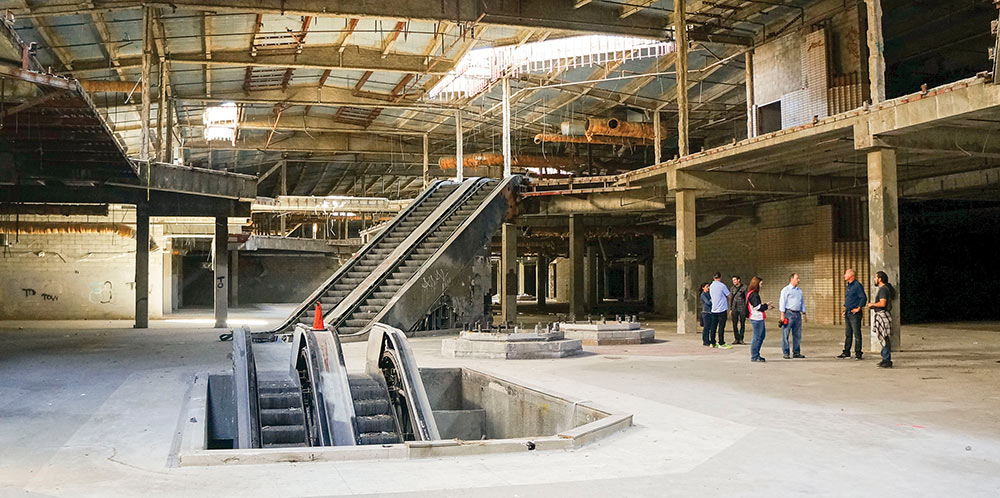
“In the Simi Valley location, we couldn’t shoot anything over a quarter-load gunfire, and they wanted to shoot 50-caliber guns. The trade-off was you got this great location, but you had to spend a little bit more money on special effects to amp up the blast of the gun.”
A special case was a Gatling gun, a forerunner of the machine gun. “That is loud and big and lets off a lot of shells,” Dillin says. “That’s not a piece of equipment we can take just anywhere.”
Horses brought other challenges. “For one scene, we had 30 horses on set,” Dillin says. “The wranglers were responsible for their health certificates and permits, but county agencies often like to see that horses are up-to-date with their shots. Sometimes we have to submit names and permits for every single animal, including chickens and donkeys. You have to treat them like a person.
“When we shot in a lot of national and state parks in Utah, we had to make sure no seeds came out of animals’ waste. Those parks don’t want non-native invasive species introduced. Every truck had to be sprayed to make sure no seeds were picked up along the way to pollinate on government land.”
Another underlying worry was starting a fire. “We had a lot of special effects and activities that were in high fire-restrictive
areas and were high fire dangers,” Park says. “And we were mov- ing at such a pace with so many units filming at once. I had to establish a relationship with the L.A. County Fire Department early on because so much work involved their oversight.”
All these concerns never crossed Dillin’s mind when she was a teenager. “I had a very urban upbringing in Toledo, Ohio,” she says. “I planned to be a cardiovascular surgeon and went to the University of Michigan in pre-med. As a kid, I was always interested in science. I had a telescope, a microscope and an aquarium full of little experiments. My father was a metallurgical engineer for Chrysler, which had a great impact on my childhood. Most girls would get dolls and stuffed animals from their fathers; my dad would bring me a super-compressed piece of steel, an array of glass beakers and the occasional lab coat.
“Since there are no doctors in my family, my interest in cardiology probably came from television shows. ER was popular when I was in high school and the Discovery Channel had just started airing documentaries about surgery. I wasn’t interested in engineering so becoming a surgeon seemed like a good alternative. It seemed like something I could absolutely do. I had steady hands from years of piano playing, I wasn’t squeamish, and surgery seemed very logical to me—cut here, stitch here and you’re done.
“It wasn’t until I started taking pre-med classes in college when I realized everything you need to do before you become a surgeon, like calculus and chemistry. My college calculus classes really kicked my butt!” Needing an elective, she signed up for a film class and ended up deciding to change her goals.
“I wanted to be a DP,” she says, “and then I heard about ADs and thought that fit my personality better. I really wanted to be in the DGA Training Program. I was a finalist and got to the interview phase. I was listed as an alternate in 2001, and that brought me to Los Angeles. I did odd jobs until I could apply again.”
One of those jobs was working as assistant to a CAA agent who represented director Oliver Stone and producer James Skotchdopole. “One day, he introduced me to Jim, who hired me as his assistant on Alexander and then later on The Revenant,” Dillin says. In 2004, she met location manager Molly Allen, who needed an office coordinator. “Working for Molly changed my life,” Dillin says. “The job with her was filing and phone calls, but it was so much more. She was an amazing mentor. She showed me the world of locations. She gave me the confidence and encouragement to pursue this career. I was hooked.
“I realized that the work of an AD is incredibly demanding and stressful. As a location manager, I’m involved in scheduling,
logistics, planning and the creative process. The best part is that I get to straddle all worlds. I get to talk to people who operate museums, parks, galleries and racetracks. Being exposed to all these really fantastic people is life-affirming.
“I love my job. I like the challenges and the thinking involved to put together the puzzle pieces.”
“I don’t want to work with anyone but Mandi,” Grobler says. “I really tried to get her on the series I’m doing now, Jack Ryan, but she’s busy doing something else. Maybe she’ll join me later.”
MANDI’S TEAM:
Key Assistant Location Managers: David Park, LMGI, Lori Russell, Diana Lara, Richard Streeter, Tada Chae, Justin Harrold, Ben Holley, Laura Brown (scout)
Assistant Location Managers: Tommy Woodard, LMGI and Eddie Santillian



